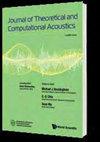扬声器有限元集总参数模型中集总单元最优值的估计
IF 1
3区 物理与天体物理
Q3 ACOUSTICS
Journal of Theoretical and Computational Acoustics
Pub Date : 2020-06-01
DOI:10.1142/S2591728520500127
引用次数: 5
摘要
有限元方法正逐渐被用来协助扬声器的不断发展。本文的核心是将有限元模型的某些部分集中在一起的方法,这大大降低了模型的复杂性,从而允许更快的结构优化。本文用一个扬声器的例子说明了这一点,其中电磁部分和蜘蛛一样集中。结果表明,简化后的模型在非常高的频率下仍然符合完整有限元模型的复杂响应。本文章由计算机程序翻译,如有差异,请以英文原文为准。
Estimation of Optimal Values for Lumped Elements in a Finite Element — Lumped Parameter Model of a Loudspeaker
Finite element methods are progressively being utilized to assist in the continuous development of loudspeakers. The core of this paper is the method of lumping certain parts of the finite element model, creating a significant reduction in the model complexity that allows for e.g. faster structural optimization. This is illustrated in the paper with a loudspeaker example where the electromagnetic parts are lumped as well as the spider. It is shown that the simplified model still matches the complex response of the full FE model at very high frequencies.
求助全文
通过发布文献求助,成功后即可免费获取论文全文。
去求助
来源期刊

Journal of Theoretical and Computational Acoustics
Computer Science-Computer Science Applications
CiteScore
2.90
自引率
42.10%
发文量
26
期刊介绍:
The aim of this journal is to provide an international forum for the dissemination of the state-of-the-art information in the field of Computational Acoustics.
Topics covered by this journal include research and tutorial contributions in OCEAN ACOUSTICS (a subject of active research in relation with sonar detection and the design of noiseless ships), SEISMO-ACOUSTICS (of concern to earthquake science and engineering, and also to those doing underground prospection like searching for petroleum), AEROACOUSTICS (which includes the analysis of noise created by aircraft), COMPUTATIONAL METHODS, and SUPERCOMPUTING. In addition to the traditional issues and problems in computational methods, the journal also considers theoretical research acoustics papers which lead to large-scale scientific computations.
 求助内容:
求助内容: 应助结果提醒方式:
应助结果提醒方式:


